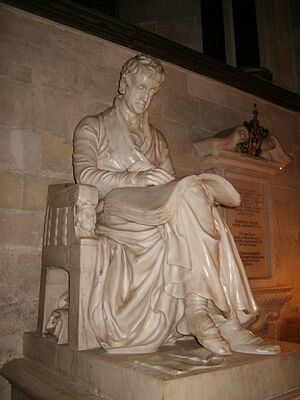Antiquarian facts for kids

An antiquarian is someone who loves to study old things. They are like history detectives! They focus on ancient history and artifacts. These are objects made by people in the past. Antiquarians also study old archaeological sites, old records, and manuscripts (old handwritten books).
Their main goal is to learn about the past using real evidence. As an 18th-century antiquarian named Sir Richard Colt Hoare said, "We speak from facts not theory." This means they prefer to find actual proof rather than just guessing about history.
Societies for Antiquarians
In the 1700s, many people became very interested in history. They started forming special groups called antiquarian societies. These groups were not part of universities. Instead, they were often made up of wealthy gentlemen who had free time.
These gentlemen were very interested in ancient Greece and its history. Some lucky people, mostly from England and France, could travel to these ancient sites. A few could even buy books with pictures of these old places. Many early antiquarians taught themselves about history.
They would write papers about their discoveries and discuss them at society meetings. Sometimes, their ideas were different from the new ways history was being taught in schools.
By the end of the 1800s, the study of antiquarianism changed. It became more specialized. New school subjects like archaeology (studying old things by digging them up) and art history (studying art from the past) took over.
Today, the word "antiquarian" is sometimes used to describe someone who focuses too much on small, unimportant historical facts instead of the bigger picture.
An antiquarian can also be someone who collects or studies antiques. These are old and valuable objects.
Images for kids
-
Ole Worm's cabinet of curiosities, from Museum Wormianum, 1655
-
"Antiquaries": portraits of 20 influential antiquaries and historians published in Crabb's Universal Historical Dictionary (1825). Featured are: Giraldus Cambrensis, John Leland, Guido Panciroli, John Stow, William Camden, Justus Lipsius, Joseph Justus Scaliger, Johannes Meursius, Hubert Goltzius, Henry Spelman, Charles Patin, Philipp Clüver, William Dugdale, Claudius Salmasius, Friedrich Spanheim, Johann Georg Graevius, Jakob Gronovius, Thomas Hearne, John Strype, and Elias Ashmole.
-
William Camden (1551–1623), author of the Britannia, wearing the tabard and chain of office of Clarenceux King of Arms. Originally published in the 1695 edition of Britannia.
-
Pit Mead Roman villa mosaic, illustrations by Catherine Downes, engraved by James Basire and presented to the SAL by Daines Barrington
-
The Puzzle (1756): etching by John Bowles. In one variation on a recurrent joke, four antiquaries struggle to decipher what seems to be an ancient inscription, but which is in fact a crude memorial in English to Claud Coster, tripe-seller, and his wife. The print is ironically dedicated to "the Penetrating Genius's of Oxford, Cambridge, Eaton, Westminster, and the Learned Society of Antiquarians".
-
Le Singe Antiquaire (c. 1726) by Jean-Siméon Chardin
-
The entrance to the premises of the Society of Antiquaries of London, at Burlington House, Piccadilly.
See also
 In Spanish: Anticuario (estudioso) para niños
In Spanish: Anticuario (estudioso) para niños








